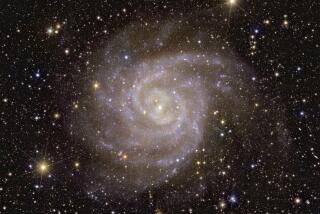Hubble Telescope Finds Hundreds of Galaxies
- Share via
SAN ANTONIO — Staring at a “blank” patch of the universe, the Hubble Space Telescope has captured images of hundreds of galaxies so faint they never before have been seen.
Some of the galaxies are about 4 billion times dimmer than what can be seen with the naked eye, astronomers reported.
Robert E. Williams, director of the Space Telescope Science Institute in Baltimore, said Monday that the findings were a treasure trove for astronomers that could possibly include the most distant, and hence the oldest, galaxies ever captured on film.
“In archeological terms, it is similar to finding a royal city, but we don’t have the dates yet,” he said. “We don’t know yet if we are seeing the most distant objects or not.”
A report on the just-completed deep space survey was delivered to the national meeting of the American Astronomical Society.
Williams said the finding was released quickly into the public domain so that the world’s astronomers could immediately begin studying the data, described by some as “the astronomical equivalent of the Dead Sea Scrolls.”
To gather the views, the Hubble Space Telescope was aimed at a specific target and allowed to capture light for 10 consecutive days.
The target was a point in the sky near the handle of the Big Dipper, a part of the universe continuously in view of the orbiting telescope.
To ground telescopes, the area seemed basically a blank part of the sky. Yet the long exposure revealed at least 1,500 galaxies in various stages of formation.
Some of the galaxies are “things we haven’t seen before,” said Andrew S. Fruchter, another Hubble team member. There are elliptical shapes and spirals. Some are like beach balls and footballs. Others are long, cigar-shaped clusters of stars.
The study is rather like taking a core sample of the Earth. Such a sample would have many layers of dirt and rock laid down over millions of years. In the celestial core sample, what is captured are views of stars and galaxies ranging farther and farther into the universe and increasingly distant in time.
Some images could be from galaxies formed within a billion years after the beginning of the universe, but Williams said this will require detailed analysis to determine.
More to Read
Sign up for Essential California
The most important California stories and recommendations in your inbox every morning.
You may occasionally receive promotional content from the Los Angeles Times.













